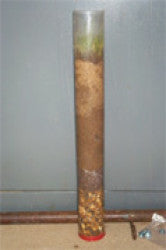Soil Analysis
The benefit of soil analysis
Soil Analysis before any major works are carried out is an absolute must do, and it is something that all clubs should carry out at least once each season. All too many people continue to follow the same work routines and fertiliser applications at their clubs, regardless that they may have serious nutrient deficiencies, or a poor soil structure.
It is a shame that for the cost of a sample analysis, you could save your club hundreds if not thousands of pounds. The improvements made to sports surfaces through recognising the nutrient levels alone can be fantastic. I hear people at clubs say the grass is 'off colour' or 'we seem to have lost a lot of grass recently'. They say that they have been putting on fertiliser, but it goes green briefly and then looks sick again. (Sound familiar!).
If they had a sample sent for testing, they would invariably find that the plant was deficient in a particular element, this could be rectified and the chances are they could then cut down on their normal quantities of feed, because the plant would take up and use the fertiliser more efficiently, now that it was no longer deficient.
Pitchcare are teaming up with European Turf grass Laboratories and will soon bring you a discounted and independent soil testing service. ETL provide a comprehensive service of analysis from basic nutrient (NPK) testing through to full USGA requirements. The importance of having independent advice means that you can make the decisions on the products and materials that may be required. All to often, the local rep from your local supplier will offer free basic analysis and then recommend something from their product range (whether or not it's the right product!).
Prior to our new service with ETL, we have asked the 'white coats' to explain some of their scientific terms and scales of measurement so that even I could understand what they are talking about- Good Luck!
If you require any more information in the meantime please contact the office on +44 (0) 1902 824392.

PERCOLATION RATE (SATURATED HYDRAULIC CONDUCTIVITY)
The rate at which soils, sands and root zones drain (normally expressed in mm/hour).
This can be affected by the depth of the root zone. Samples are usually equilibrated overnight to 30cms tension - this being the standard depth of a USGA (United States Golf Association) green, from the surface to the gravel drains. After 16 hours, and compacting to 45 ft/lbs pressure, they are transferred to a permeameter (see photograph below), and percolation rate is determined once the samples have been percolating for a minimum of four hours. Equilibrating to higher or lower tensions will cause the percolation rate to rise or fall. 45 ft/lbs compaction is considered the average compaction a golf green will be subjected to as a result of foot and vehicle traffic.

300 - 600 mm/hr (Accelerated Range - extreme weather conditions)
TOTAL POROSITY
This is the sum of air-filled and water-filled pore spaces present in the root zone in the compacted state (normally expressed as a %). The ideal root zone should consist of a good balance of air-filled and water-filled pore spaces leading to favourable drainage properties with enough moisture retention for grass growth.
USGA Recommends : 35 - 55 %
AIR-FILL POROSITY
This is a measure of the air-filled pores (large pores) present in compacted root zone (normally expressed as a %). These pore spaces are the ones through which water drains and air enters the root zone. Grass roots are also able to penetrate the root zone through these pore spaces. Greater depths of root zone will encourage a higher % of air-filled pore space because the greater tension draws more water out of the root zone.
USGA Recommends : 15 - 30 %
WATER-FILLED POROSITY (CAPILLARY POROSITY)
This is a measure of water-filled pores (small pores) present in compacted root zone (normally expressed as a %). These are the pores that retain water and are obviously necessary within a root zone in order to sustain grass growth. Greater depths of root zone will discourage water retention while shallower root zones will retain more water.
USGA Recommends : 15 - 25 %
BULK DENSITY
This is a measure of the weight of dry soil per unit of bulk volume, including air space (normally expressed as g/cc). ETL results are based on compacted, dried root zone. Sand/peat root zones with high levels of organic material are likely to have lower bulk densities than sand/soil root zones that have lower organic contents. Average bulk densities in root zones tend to range from 1.4 - 1.65 g/cc.
PARTICLE DENSITY
This is a measure of the weight per unit volume of the soil particles (normally expressed as g/cc). The particle density is influenced by the chemical composition and crystal structure of the mineral particles and is not affected by pore space.
WATER RETENTION
This is a measure of the % of water present in the root zone at a given tension. No USGA recommendation is given but acceptable values are usually 12-16%.
USGA RECOMMENDED PARTICLE SIZE DISTRIBUTION FOR ROOT ZONES
|
NAME |
PARTICLE DIAMETER (mm) |
RECOMMENDATION (by weight) |
|
|
Fine Gravel |
2.0 - 3.4 |
Not more than 10% of total particles, including a max. of 3% fine gravel |
|
|
Very Coarse Sand |
1.0 - 2.0 |
(preferably none) |
|
|
Coarse Sand |
0.5 - 1.0 |
||
|
Medium Sand |
0.25 - 0.5 |
Minimum of 60% of particles |
|
|
Fine Sand |
0.15 - 0.25 |
Not more than 20% of particles |
|
|
Very Fine Sand |
0.05 - 0.15 |
Not more than 5% |
|
|
Silt |
0.002 - 0.05 |
Not more than 5% |
Total not more than 10% |
|
Clay |
<0.002 |
Not more than 3% |
|
